Ryan Murphy’s Beautiful Stylized Choir Room

Image source: Youtube
“Glee”: who can forget the worldwide sensation that set the tone of the early 2010’s for millions of teens and tweens? Besides having more iTunes-chart-topping covers than any other television show (sorry “The Voice”!), “Glee” also stands out as one of the most over-the-top, scathing, and beloved shows that television powerhouse Ryan Murphy (the creative force behind such shows as “American Horror Story”, “Pose”, and, most recently, “The Politician”) has produced to date.
While the first two seasons of “Glee” were co-written by the shows co-creators—and Murphy-collaborators—Brad Falchuk and Ian Brennan, Murphy’s signature snark shines through as perhaps the show’s most distinctive voice. In “Glee”’s six season run Murphy played up and subverted high school tropes, provided an inexhaustible supply of self-critiquing rejoinders, and gave us more inexplicably lavishly produced musical numbers and truly bizarre wardrobe choices than seem possible. This, for me, is “Glee”’s best quality: Murphy’s exaggeration and ironic self-awareness, a quality of his writing he describes as “baroque.”
But while this sense of spectacle is a Ryan Murphy trademark, the set-up of “Glee” seems uniquely well-suited for Murphy’s stylization. Murphy’s approach takes archetypes and turns the volume up to eleven. Production-wise, he seeks shots with the most visual impact, the most potential for theatrical awe. In writing and in mood, Murphy wants the most drama, and as a show centered around a show choir of high school misfits, “Glee” was destined to be Murphy’s star student. In other words, “Glee”’s inherently dramatic setup was the perfect stage for Murphy’s stylization to function as a key plot device, rather than just a witty and visually pleasing show feature.
To start, any show set in high school presents writers with a delicious tray of clichés to play with and either subvert or uphold. To Murphy, who thrives on taking an established caricature, crystalizing it in the most cliched way possible, and then diving beneath its stereotyped veneer, high schools are a treasure trove of a setting. Just look at the characters on “The Politician”: the protagonist, Payton, isn’t just an overachieving privileged teen with presidential aspirations; he is an absurdly wealthy teen with a CV curated into sterility, completely at the mercy of his ambition. But the flipside of his endless, obsessive drive towards success is the depth of his emotional repression.
Deploying tropes to attain depth contrasts with the strategies of other high school dramas, such as the CW’s comically melodramatic “Riverdale.” While the Archie-comics-based characters on the show are perhaps the pinnacle of exaggerated cliché, it is amplification without an emotional payoff. When moody loner Jughead delivers a monologue about how he doesn’t “want to fit in,” every line is so picked over and trite that it alienates the audience; it feels more like satire than a genuine expression of pain. While this is entertaining, it does little to inspire a sense of relatability or empathy.
This is one problem with clichés: as useful as they are in serving as a recognizable template for different narratives, their standardization renders them emotionally flat. Specificity breeds poignancy, which can never happen if a character operates solely within an arc designed for genericism.
But this generalized quality is also what makes clichés so ubiquitous. Who among us wasn’t raised on an idea of the jock, or the “bookish type,” or sold on an idea of romantic love? And, eyes filled with the uncomplicated fulfillment that such tropes promise, who hasn’t wished to become such a cliché?
This is the beauty of “Glee”: crafting characters whose desire to achieve an impossible dream is reflected in (and enhances) their emotional depth. Take Finn Hudson, who starts the series as the classic popular quarterback dating the head cheerleader, but whose character arc is ultimately about searching for purpose after realizing he has failed at pursuing his high school dreams. Finn’s failure to realize his dreams after high school begins his disintegration as a cliché; he can no longer rely on his ideas of manhood and success, ideas that have now failed him. This, in turn, reflects a very true to life experience of realizing that life isn’t like the movies.
This destruction of cliché is achieved through the consistent exaggeration of the qualities that make him a cliché. Finn’s lack of intelligence and dogged pursuit of externally-prescribed success is (sometimes) exaggerated to the point of satire. This signals to the audience two things: one, that the writers are aware of the cliché they are using and two, it makes Finn’s disintegration as a cliché that much more jarring. When Finn looks around and realizes that high school is over, that being the star football player or ‘making it’ on Broadway aren’t options for him, he has to flounder to figure out who he is outside of these things. And we, as the audience, have understood him so principally as this cliché that we feel just as devastated as he does when we realize how lost he is without this archetype anchoring him.
By thus using exaggerated cliché as a character device, the whole show becomes more dramatic. If a character’s veneer is overly sculpted artifice, then the other side of their personality, their emotional side, holds just as much tension. Consider Santana Lopez, introduced as the quintessential hot, manipulative, and mean-spirited cheerleader, but who experiences deep internal conflict around her sexuality and being rejected by Britney, the best friend she is in love with. When Santana cries as she sings “Landslide” with Britney, we feel doubly for her, because we now understand this pain in the context of a generally very dramatic character. Because she is so intensely this character, her strife is also more intense.
This depth that subverting clichés creates is particularly significant for the portrayal of queer characters on “Glee”. Though queer representation in television has come a long way, many representations continue to be dogged by negative stereotypes or else are not afforded the same depth that heterosexual, cisgender characters are. While there is no question that “Glee” engages queer stereotypes—in season one the openly gay Kurt’s response to his father pointing out his aversion to watching sports is to splutter about the ugliness of the players’ pants—it is typically so contrived as to clearly be a joke. When combined with the emotional complexity and relatively wide range of representation that “Glee” offers its queer characters, this use of cliché satirizes what we’ve come to expect from queer representation, rather than reinforcing it.
This hyper stylization mixed with hyper emotionality contributes to the overall melodrama of the show, a quality that is completely necessary in a television show about show choir. The show is centered around frequent, often semi or fully imaginary musical numbers that function as an emotional catharsis for the characters. For such numbers to feel in tandem with the rest of the show, the emotional stakes must constantly be set very high. For instance, when Mercedes sings Whitney Houston’s “I Will Always Love You” the scene toggles between Mercedes performing the song alone on a stage, decked out in a sequined floor length gown, and in the glee choir room, singing directly to the boy she is saying goodbye to. For the show to earn the full emotional impact of Mercedes belting out her heartbreak alone onstage, the pain and betrayal that precipitated the song had to be devastating. Thus, Ryan Murphy’s stylization fits perfectly.
“Glee” was the perfect landscape for Ryan Murphy’s predilection towards stylization and drama, and as such created a show that was self-aware, heartfelt, and shockingly intense for a show that could have been a trite excuse to cover pop songs. As “Glee”’s ten year anniversary draws to a close, and Ryan Murphy signs the biggest television contract of all time, it feels only fitting to pay homage to one of Murphy’s greatest accomplishments.




